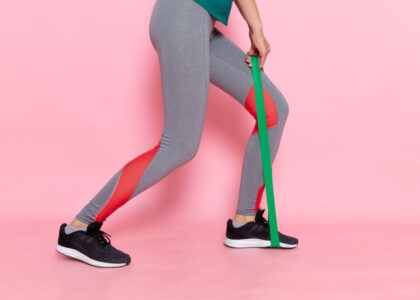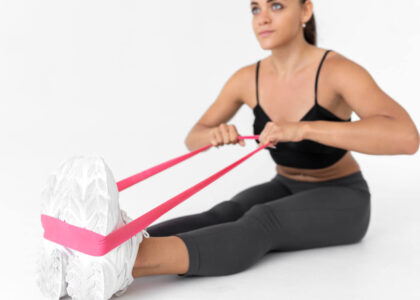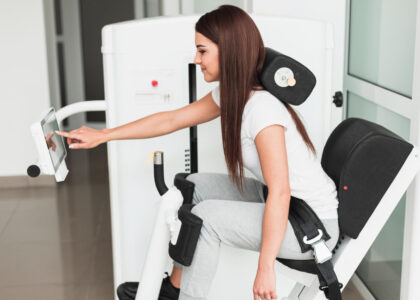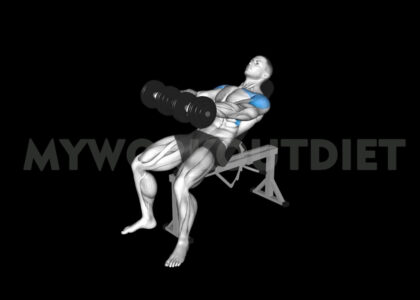CHEST | SHOULDERS | BICEPS | TRICEPS | LEG | ABS | NUTRITION
Are you prepared to achieve the full potential of your training? Deadlifts, among the most fundamental exercises for fitness, can assist you in getting there. If you’re a fitness freak, an experienced lifter, or just looking to improve your fitness level, know what muscles does deadlift work to maximize your results.
In this thorough guide, we’ll dive deep into deadlifting and discover the secrets behind the muscles involved in this powerful exercise. If you become aware of the forces targeted in this exercise, you can improve your technique, boost your performance, and create an athletic, more muscular body.
So, prepare to grab that bar with your hands to experience the heat and feel the transformational effects of the deadlift on your body. Whether you’re trying to tone your lower body part, build the core or increase your overall body fitness, this article will equip you with the information and information you need to elevate your exercise routine to a new level.
Let’s explore the deadlift muscles worked.
How To Deadlift Properly : Technique
Learning the correct technique is very important to lifting deadlifts efficiently and safely. Before we get into what muscles does deadlift work, let’s spend a few minutes learning the proper method of execution and form of this exercise.
Deadlifts are typically performed by lifting a barbell loaded with weight from the floor to stand up while maintaining a solid and steady position. The process is broken into a couple of crucial steps:
1. Starting Position: Stand with your feet about hip-width apart and your toes should be pointing slightly toward the side. The barbell should rest on your middle foot. Gently bend your knees, lift the hinge at your hips, and hold the bar beyond your legs. You can use either a mixed grip or an overhand grip.
2. Set your back: Contract your core muscles and then retract your shoulder blades to reach an upright spine. Keep your chest lifted and keep a slight arch in the lower part of your back.
3. Lift Off: Exhale and use your heels, engage your hips, and then straighten your legs as you raise the barbell off of the floor. Ensure to maintain a smooth, controlled movement and avoid twisting or rounding to the back.
4. Full Extension: Stand tall with fully engaged knees and hips. Maintain the spine in a neutral position. Press your glutes to the top of your movement to activate your posterior chain.
5. Lowering the barbell: Reverse the movement by leaning on the hips and bending your knees to lower the barbell to the floor. Keep control through the descent, and avoid rounded back and sudden drops.
Correct form is essential for activating targeted muscles and reducing the chance of injury. By following our guidelines for the deadlift technique, your forces of choice are adequately engaged during the entire lift.
With knowledge of deadlift techniques, let’s move on to the most exciting aspect: what does deadlift work? Knowing the specific muscles involved will allow you to comprehend better the total body benefits deadlifts provide.
Let’s Discuss What Muscles Does Deadlift Work?
The conventional deadlift is an effective exercise that works several muscles and makes it an excellent option for building strength and the size of your muscles. Let’s look at the main muscles that come to play in the conventional deadlift.
1. Glutes: The gluteal muscles, which include the gluteus medius, gluteus maximus and minimus, are heavily engaged when you deadlift. They are essential in extending the hips, the primary movement pattern during this workout. The strength of your glutes is a critical factor in improving fitness, power production, and aesthetics of the lower part of your body.
2. Hamstrings: The posterior chain of muscles, specifically the hamstrings, play an essential part during the deadlift. These muscles cooperate to extend the hips and also provide stability throughout the move. Strong hamstrings not only improve your deadlift performance but can also aid in balanced leg and lower body strength.
3. Quadriceps: The deadlift is designed to target the posterior chain. The quadriceps also get involved as they aid in the extend your knees while lifting. While they are not the primary goal, the quadriceps are essential in supporting the movement, contributing to the power and stability move.
4. Lower Back: The erector Spinae muscles on the opposite side of the back get incredibly engaged when you deadlift. They’re responsible for ensuring that your back remains straight and your spine’s stability throughout the exercise. A healthy lower back is crucial for protecting yourself from injuries and maintaining a healthy posture.
5. Core: Deadlifts are an excellent exercise to build a solid core. The muscles of your abdominals, including the transverse abdominis and the Obliques, ensure stability and avoid overly flexion of the spine. A substantial body increases your deadlift performance and improves overall endurance and balance.
When you incorporate the conventional deadlift into your workout routine, you can target these crucial muscles, resulting in greater strength, better posture, and overall physique.
Please read this section for more information on the muscles used during deadlift exercises and their distinctive advantages.
Exploring Deadlift Variations and Muscle Targeting
Although the standard deadlift is the most common exercise in any strength-training program, different variants offer unique benefits and target specific muscles. Let’s look at some of these variations and learn how they affect the muscles that are worked:
1. Dumbbell Deadlifts: Dumbbell deadlifts can be a fantastic alternative for new or unable-to-access barbells. This type of exercise targets the same muscles as the conventional deadlift, which includes the glutes, hamstrings, lower back, quadriceps and core. The fact that dumbbells are unilateral deadlifts can help to correct any imbalance in strength between the right and left sides of your body.
2. Single-Leg Deadlifts: Single-leg deadlifts are also called unilateral deadlifts; change the focus to stability and balance while focusing on your posterior chain. This variant is particularly challenging for the hamstrings, glutes, and core. Furthermore, it puts more weight on the stabilizing muscles in the ankles and hips, improving proprioception and balance.
3. Stiff-Legged Deadlifts: Stiff-legged deadlifts, also called Romanian deadlifts, focus more on the hamstrings and the glutes. By keeping an incline of just a little bit during the entire movement, the hamstring muscles get continuously stretched, which results in increased flexibility and strength of the hamstrings. Deadlifts with stiff legs also work muscles in the lower back and the core to an extensive degree.
4. Trap Bar Deadlifts: The trap bar, often called the hex bar, provides a different variant of deadlifts that can make it more relaxing for specific individuals and less stress on the lower back. The deadlifts of the trap bar concentrate on the same muscles as the standard deadlift but with particular emphasis on the glutes, hamstrings, and quadriceps. The grip’s location and centre of gravity for the deadlift with trap bars can aid in promoting a more upright torso posture.
5. Romanian Deadlifts: Romanian deadlifts (RDLs) are exercises that focus on controlled eccentric (lowering) movements. This particular variation targets the glutes, hamstrings, and lower back. RDLs are great for strengthening muscles in the back and hips and improving the mechanics of hinges.
Adding these deadlift variants into your workout routine will allow you to focus on particular muscle groups, correct muscular imbalances, and provide variety to your workouts. Try different options to discover the best suits your needs and goals.
In the next part, we’ll look at other muscle groups involved during deadlifts to give you knowledge of the impact of the exercise on your body.
Additional Muscle Groups Engaged in Deadlifts
While the primary goal of deadlifts is the muscle groups that we’ve covered in the past, however, there are a few additional muscles that are engaged during deadlift movements and provide overall strength and stability. Let’s make an look at these muscles:
1. Traps and Upper Back: Deadlifts work those muscles in the upper of your back, including the trapezius, rhomboids, and rear deltoids. The muscles in these groups work together to support the back and ensure correct posture during the lifting. The upper back must be solid and stable to maintain a secure and effective deadlift technique.
2. Forearms and Grip: A firm grip and forearm muscles are required from grabbing to lifting the barbell. Your forearms and grip strength will be tested when you lift heavier weights. Strengthening these muscles will not only enhances your deadlifting performance but also increases your capacity to complete other workouts which require grip strength.
3. Calves: Though not the main focus of deadlifts, the calves serve an essential role in stabilizing exercise. When you push into your heel and raise your hips, your calves’ muscles maintain stability and balance. While calf involvement is not as evident as when you do exercises such as lifts for the calf, deadlifts can provide another benefit for the calf muscle.
Building strength and stability in these muscles is vital to improving your deadlifting performance and general fitness.
To fully understand the advantages of deadlifts and their effects on muscle growth in general fitness, keep reading this section.
Deadlift Benefits For Muscle Development and Overall Fitness
Deadlifts have a myriad of advantages that go beyond just the ability to target specific muscles. Let’s look at the benefits of including deadlifts in your exercise routine:
1. Muscle Development: Deadlifts are a compound exercise that activates several muscles simultaneously. This exercise is a compound that stimulates substantial muscular activation, leading to general muscular development and increases in strength. By focusing on the glutes, quadriceps, hamstrings, lower back, and core, deadlifts offer total body exercise.
2. Strength and Power: As a compound exercise, deadlifts are great for building physical strength and power. Through engaging various muscles, deadlifts increase the capacity of your body to generate energy. This results in improved athletic performance in many activities and sports.
3. Body Composition and Metabolism: Deadlifts are an extremely efficient exercise to promote weight loss and improve body composition. Because of the high muscle activation involved in deadlifts, they increase the calories burned both in and after the workout. In addition, the increase in lean muscle mass through deadlifts can improve your metabolic rate during rest and increase calorie burning all day.
4. Posture and Health of the Spine: Deadlifts can help improve spine alignment and posture by engaging the muscles in the back, which includes those of the erector spine. Deadlifts may help ease lower back pain and enhance general spinal wellness by involving the spine’s core and stabilizing it.
5. Functional fitness: Deadlifts are helpful for actual movements like lifting heavy objects from the ground. Training your body’s muscles to raise using proper technique and form deadlifts increase functional fitness and boosts everyday activities, making things such as lifting groceries or moving furniture safer and more accessible.
Integrating deadlifts into your exercise routine could change the body’s composition, strength and overall fitness if you consistently push yourself to the limit with the proper form and gradual overload and reap the benefits of this exercise.
In the final section, we’ll review the main points we’ve covered and urge readers to continue their journey towards unlocking the full potential of deadlifts.
Conclusion
Congratulations! You’ve now gained in-depth knowledge of the what muscles does deadlift work and this exercise’s fantastic benefits. Let’s review the most important details we’ve covered:
- Deadlifts target a broad range of muscles, including the glutes and hamstrings, quadriceps, lower back and core. These muscles give you stability, strength and endurance throughout the lifting.
- Deadlift variations such as single-leg deadlifts, dumbbell deadlifts, stiff-legged deadlifts, trap bar deadlifts, and Romanian deadlifts permit you to focus on specific muscle groups and meet your individual goals and needs.
- In addition to the main muscle groups, deadlifts also engage the traps, upper back, grip, forearms, and calves, thereby contributing to stability, strength, and functional strength.
- Deadlifts offer numerous benefits, including the development of muscles, enhanced power and strength, enhanced body metabolism and composition, better spinal and posture health and a better functional fitness level for all-day tasks.
Once you’ve mastered the science and the potential of deadlifts, it’s time for you to implement this knowledge. Include deadlifts in your exercise routine, with correct form and gradual overload, to maximize the benefit and realize your body’s full potential.
Remember, just like every exercise, and it’s crucial to start with the right weight and gradually increase it as your strength and skill improve. Always be mindful of safety and be aware of your body as you go through the exercise.
Keep your fitness journey going by looking through related articles and resources on our site. If you want to improve your diet, explore different exercises, or learn about various practices, we have plenty of resources to help you reach your goals.
Get into the deadlift’s ring and experience the transformational impacts on your body, strength, and overall well-being. Get your body in shape and push yourself to be the best in each rep, set and deadlift you can conquer.
What is deadlift good for ?
Deadlifts are compound exercises and are excellent for building overall strength and power. They target multiple muscle groups, such as the back, legs and core. They also help improve grip strength. They can improve posture as well as improve fitness levels.
What size bar should i use for a deadlift?
For deadlifts, it’s suggested to use an Olympic barbell, which usually weighs 20 kg (45 pounds) and is 7 feet long. However, there are smaller options for women, like bars weighing about 15 kg (33 pounds) and having a smaller diameter. Pick a bar that is suitable for your ability to lift and comfort.
How to use deadlift straps ?
It would be best if you looped your straps around the barbell and then your wrist for deadlifts. Hold the bar in your hands without using the straps. As you raise the bar, the straps will provide grip support. Utilize straps sparingly to maintain the strength of your grip, focus on the correct technique, and gradually increase your grip strength as time passes.
What is the world record for deadlift ?
The world record-setting for deadlift is held by Hafthor Bjornsson, who lifted an incredible 501 kilograms (1,104 pounds) on May 2nd 2020. The remarkable feat occurred during Thor’s Power Gym in Iceland and was recognized by the official as the deadlift with the most weight recorded in the sport’s history.
How many reps for deadlift ?
The ideal rep range for deadlifts typically falls between 1 to 5 reps per set. This focuses on building strength and power. However, rep ranges can vary based on goals and abilities. Choosing a weight range that suits your specific needs and maintains proper form throughout the exercise.
How to warm up for deadlift ?
For warming up for deadlifts, begin with 5-10 minutes of moderate cardiovascular exercise. Then, perform dynamic stretches that target the hamstrings and hips and then lower back. Begin with lighter sets of deadlifts, slowly increasing the weight. Prioritize activation and mobility exercises in order to get your body ready for the exercise.
Average deadlift for 14 year old ?
The average deadlift for a 14-year-old can vary dramatically based on factors such as body weight, experience in training and genetics. It is best to concentrate on the correct technique and form and gradually increase weight as time goes by. Begin with lighter weights and then aim for the weight that will challenge you and maintains a good record—getting advice from a certified trainer or coach.
What muscles does deadlift work ?
Deadlifts engage various muscle groups, including the erector spine (lower back), glutes, hamstrings and quadriceps. They also work the calves, grip muscles and forearms. Additionally, it engages core muscles, including the abdominals and the obliques, making it a highly efficient compound exercise that improves overall strength and development of muscles.
How much should i be able to deadlift ?
The amount you’ll need to be able to deadlift will depend on your body weight, strength level and experience in training. Make sure you are making steady progress towards the goals you have set for yourself. Begin with an exercise that you can perform with correct form, and strive to increase it as time passes.
Deadlift alternative ?
Kettlebell swing , Cable pull-through , Bent-over row , Back extension , Single-leg Romanian deadlift , Farmer’s walk/farmer’s carry , Good morning with dumbbells , Glute bridge and barbell hip thrust , Pistol squat , Trap bar deadlift.
